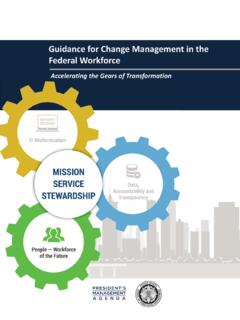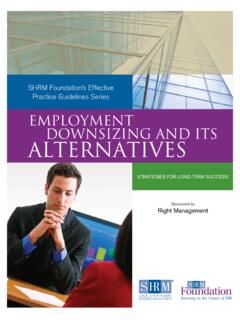Transcription of Earned Value Management Tutorial Module 6: Metrics ...
1 Earned Value Management Tutorial Module 6: Metrics , performance Measurements and forecasting Prepared by: Module 6 Metrics , performance Measures and Forecasting2 Prepared by: Booz Allen HamiltonModule 6: Metrics , performance Measurements and ForecastingWelcome to Module 6. The objective of this Module is to introduce you to the Metrics and performance measurement tools used, along with forecasting , in Earned Value Topics that will be addressed in this Module include: Define Cost and Schedule Variances Define Cost and Schedule performance Indices Define Estimate to Complete (ETC) Define Estimate at Completion (EAC) and Latest Revised Estimate (LRE) Module 6 Metrics , performance Measures and Forecasting3 Prepared by: Booz Allen HamiltonReview of Previous ModulesLet s quickly review what has been covered in the previous modules.
2 There are three key components to Earned Value : Planned Value , Earned Value and Actual Cost. PV is the physical work scheduled or what you plan to do . EV is the quantification of the worth of the work done to date or what you physically accomplished . AC is the cost incurred for executing work on a project or what you have spent . There are numerous EV methods used for measuring next step is to stand back and monitor the progress against the performance measurement Baseline (PMB). Module 6 Metrics , performance Measures and Forecasting4 Prepared by: Booz Allen HamiltonWhat is performance measurement ?
3 performance measurement is a common phrase used in the world of project Management , but what does it mean? performance measurement can have different meanings for different people, but in a generic sense performance measurement is how one determines success or failure on a project. How then can performance measurement have different meanings for different people? To answer this question, consider the ACME House Building project. You have two major stakeholders on this project, the Buyer and the Builder. Do you think they both measure success on the project identically or do you believe their definition of project success may be different?
4 Let s take a look on the next 6 Metrics , performance Measures and Forecasting5 Prepared by: Booz Allen HamiltonWhat is performance measurement ?It seems logical to say that they both want a home that provides security, meets building code, and keeps them warm in the winter and cool in the summer. Now let s look at possible differences in the way they define successful performance on the you see how different parties or individuals can have conflicting views of what defines project success?Buyer Home has 4 bedrooms, 3 bathrooms Backyard is landscaped for children to play Two car garage Walls don t have paint streaks Carpeting is correct colorBuyer Home has 4 bedrooms, 3 bathrooms Backyard is landscaped for children to play Two car garage Walls don t have paint streaks Carpeting is correct colorBuilder Completed on time Within contract price Sells within first two months Less than 10% Post-sell maintenance Builder Completed on time Within contract price Sells within first two months Less than 10% Post-sell maintenance Module 6 Metrics .
5 performance Measures and Forecasting6 Prepared by: Booz Allen HamiltonWhat is performance measurement ?The Stakeholders (Buyer and Builder in the ACME House Building Project) should understand how each party defines project success and what each party measures to determine that the case of Earned Value Management , performance measurements focus on cost and schedule Cost Management focuses on the cost performance of the project. It looks at the relationships between the Earned Value (EV) and the Actual Cost (AC).The Schedule Management focuses on the schedule performance of the project. It looks at the relationships between the Earned Value (EV) and the Planned Value (PV).
6 Now let s look at these relationships in more detail on the following 6 Metrics , performance Measures and Forecasting7 Prepared by: Booz Allen HamiltonEarned Value : Metrics and performance MeasurementsEarned Value performance measurements look at the project cost and schedule performance by analyzing the cost and schedule variance along with cost and schedule efficiency. The formulas used are as follows:Variance AnalysesCost Variance (CV) = Earned Value (EV) Actual Cost (AC)Schedule Variance (SV) = Earned Value (EV) Planned Value (PV) performance IndicesCost performance Index = Earned Value (EV)/Actual Cost (AC)Schedule performance Index = Earned Value (EV)/Planned Value (PV)Let's take a look at the Variance Analyses on the next 6 Metrics , performance Measures and Forecasting8 Prepared by: Booz Allen HamiltonVariancesThe Cost Variance (CV)is the difference between the Earned Value of work performed and the actual cost.
7 Cost Variance (CV) = EV ACIf the result is POSITIVE, project is experiencing an Underrun If the result is NEGATIVE, project is experiencing an Overrun Module 6 Metrics , performance Measures and Forecasting9 Prepared by: Booz Allen HamiltonVariances: Cost Variance exampleUsing the ACME Home Building project information from Module 5, let's calculate the Cost Variance (CV) for the project. CV = EV ACCV = $33,149 - $ 32,400CV = $749 What does this tell you? Look at the explanationon the next of 1/31 PVEVACF oundation$15,394 $15,394 $15,850 Patio$8,166$8,166$7,200 Exterior Walls$8,748$6,608$6,250 Stairway$5,961$2,981$3,100 Project Total$38,269 $33,149 $32,400 CostVarianceTimeCostPV = $38,269EV = $33,149 AC = $32,400 1/31 Module 6 Metrics , performance Measures and Forecasting10 Prepared by: Booz Allen HamiltonVariances: Cost Variance exampleA Cost Variance of $749 tells you that the project is Underrun or under note that the cost variance, along with all other performance analyses tools, can be computed (or assessed) in terms of cumulative and current.
8 Since we are in the first status period in our example, the cumulative and current are the the graph to right, you can see that on 1/31 the EV line (green) is above the AC line (red). This means that it cost less to accomplish the work then was budgeted, thus a positive cost 's look at another Cost Variance calculation on the next = $38,269EV = $33,149 AC = $32,400 1/31 Module 6 Metrics , performance Measures and Forecasting11 Prepared by: Booz Allen HamiltonVariances: Cost Variance exampleAnother calculation for reviewing Cost Variance (CV) is CV%. Using our example, what is the CV%?CV = EV ACCV% = CV/EVCV = $33,149 - $32,400CV% = $749/$33,149CV = $749CV% =.
9 023 or date the project has a Cost Variance of $749 or Variance (CV)% = CV/EVTells you what percentage cost varies from what has been Earned to 6 Metrics , performance Measures and Forecasting12 Prepared by: Booz Allen HamiltonVariancesThe Schedule Variance (SV)is the difference between the Earned Value of work performed and the work scheduled. SV tells you the Value of work performed less Value of work Variance (SV) = EV PVIf the result is POSITIVE, project is on schedule or exceeding the scheduleIf the result is NEGATIVE, project is behind scheduleModule 6 Metrics , performance Measures and Forecasting13 Prepared by: Booz Allen HamiltonVariances: Schedule Variance exampleUsing the ACME Home Building project information from Module 5, let's calculate the Schedule Variance (SV) for the project.
10 SV = EV PVSV = $33,149 - $38,269SV = -$5,120 What does this tell you? Look at the explanationon the next of 1/31 PVEVACF oundation$15,394 $15,394 $15,850 Patio$8,166$8,166$7,200 Exterior Walls$8,748$6,608$6,250 Stairway$5,961$2,981$3,100 Project Total$38,269 $33,149 $32,400 ScheduleVarianceTimeCostPV = $38,269EV = $33,149 AC = $32,400 1/31 Module 6 Metrics , performance Measures and Forecasting14 Prepared by: Booz Allen HamiltonVariances: Schedule Variance exampleA Schedule Variance of -$5,120 tells you that the project is Behind the graph to right, you can see that on 1/31 the EV line (green) is below the PV line (blue).















